1964 Penny Coin Value: How Much Is It Worth?
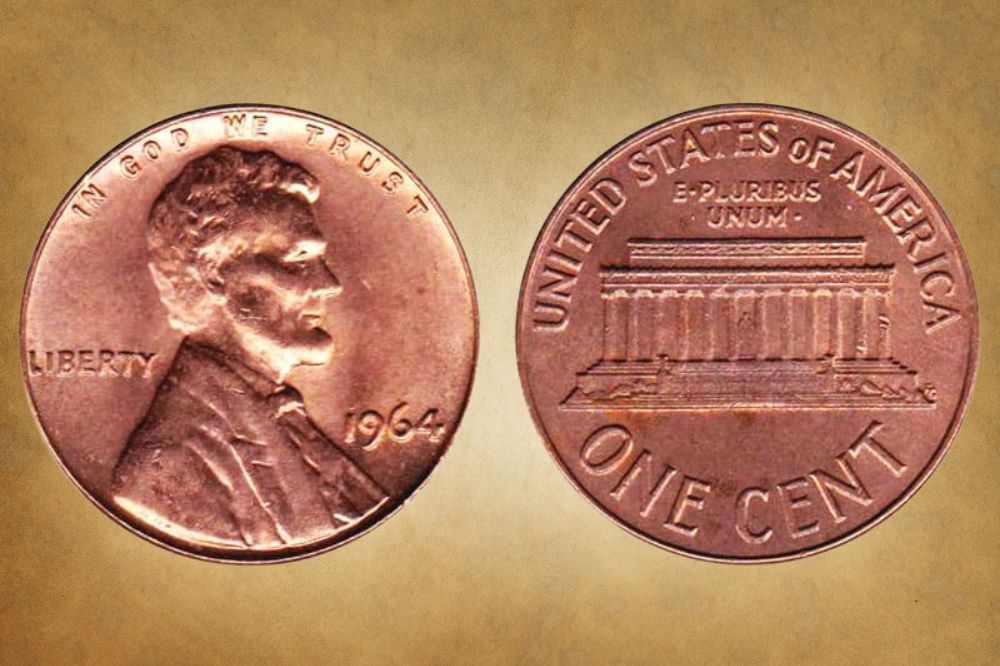
Pennies (or Lincoln Cents) are often subcategorized by their design. They include Wheat Pennies (1909 to 1958), War Pennies (1942), Memorial Pennies (1958 to 2008), Shield Pennies (2010 to Date), and Bicentennial Pennies (2009). The 1964 Cent is a Memorial Cent.
This means it features the Lincoln Memorial at the back. Also, in most years, no mint mark means the coin came from Philadelphia. But in 1964, both (P) coins from Philadelphia and (S) coins from San Francisco had no mint marks. So let’s authenticate the 1964 Penny Value.
1964 Penny Value Chart
| Mint Mark | Good (G 4) | Uncirculated (MS 60) | Mint State (MS 65) | Proof (PR 65) |
| 1964 No Mint Mark Penny Value | $0.02 | $0.17 | $0.33 | $1.71 |
| 1964 D Penny Value | $0.02 | $0.17 | $0.33 | No D Proofs |
1964 Penny Value Guide
At least half the pennies that have the 1964 mint date were coined in 1965. Also, starting late in 1962, the tin was quietly removed from 1-cent coins. So while the earlier coins were bronze (95% copper + a 5% mix of tin and zinc), pennies after 1963 are sometimes classified as brass pennies because they have copper and zinc but no tin. Let’s look at the value by sub-category.
1964 (P) No Mint Mark Penny Value
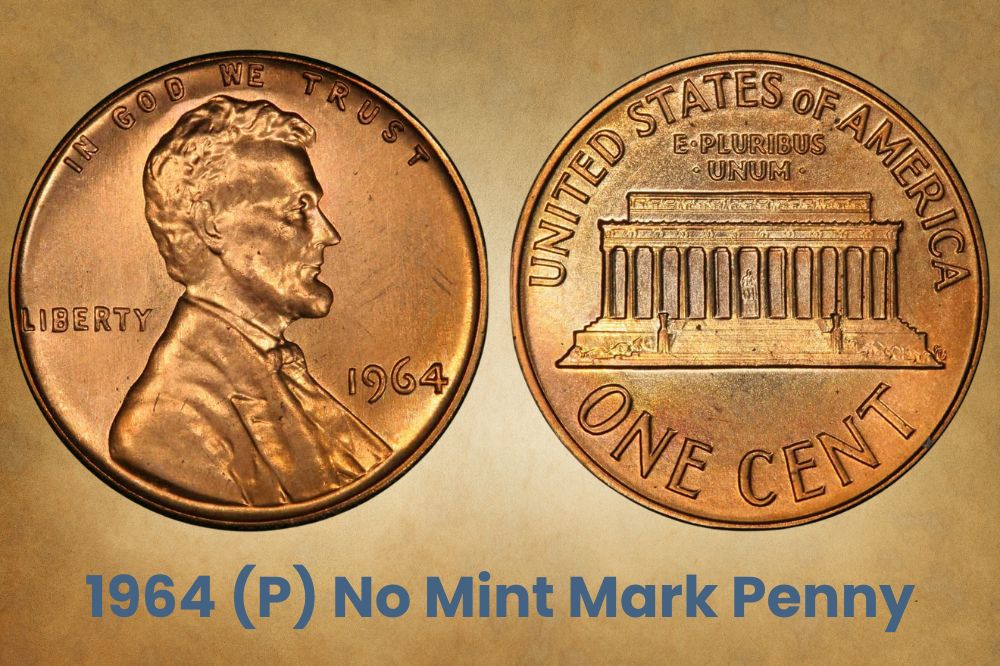
The Philadelphia Mint released 2,451,945,000 dated 1964, though about a billion of these were struck in 1965. They also produced 3,950,762 proof coins. None of these coins bear mint marks. They’re worth 2 cents, based on the melt price of copper in November 2022. But since the absence of a mint mark could mean Philly or Frisco, some can sell over $10,000.
1964 (S) No Mint Mark Penny Value
Officially, the coin minting section of the San Francisco Mint was closed from 1955 to 1968. But some coins were made during that period, except they had no mint marks. And in 1964 particularly, the coins were assumed to come from Philadelphia. But 1964 had 196,630,000 San Francisco cents. And while these coins were all dated 1964, they were all coined in 1965.
Since none of these coins had mint marks, you can’t verifiably distinguish 1964 Philadelphia pennies from 1964 San Francisco pennies. Some people claim they don’t even exist! Instead, the San Francisco cents are lumped with Philly cents and labeled No Mint Mark 1964 Cents. In MS 67 RD, they can sell for $5,700. PCGS appraised one 1964 MS 67+ Penny at $13,500.
1964 D Penny Value
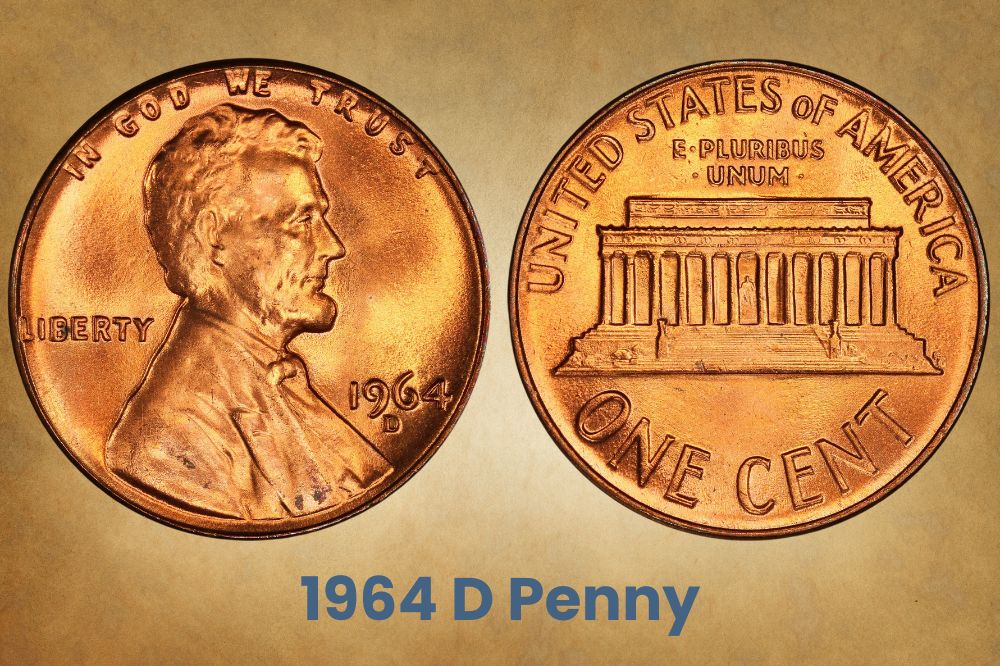
A total of 3,799,071,500 pennies carry the 1964 minting date. But although they’re all stamped 1964, close to 2B of these coins were produced in 1965. And even though it’s the only 1964 Penny with a mint mark, its value isn’t that high. A 1964 D in MS 67 RD sold for $456. PCGS graded 3 unsold 1964 D Pennies in MS 67+ at $4,750. One was sold for $7,900.
1964 (P) Proof Penny Value
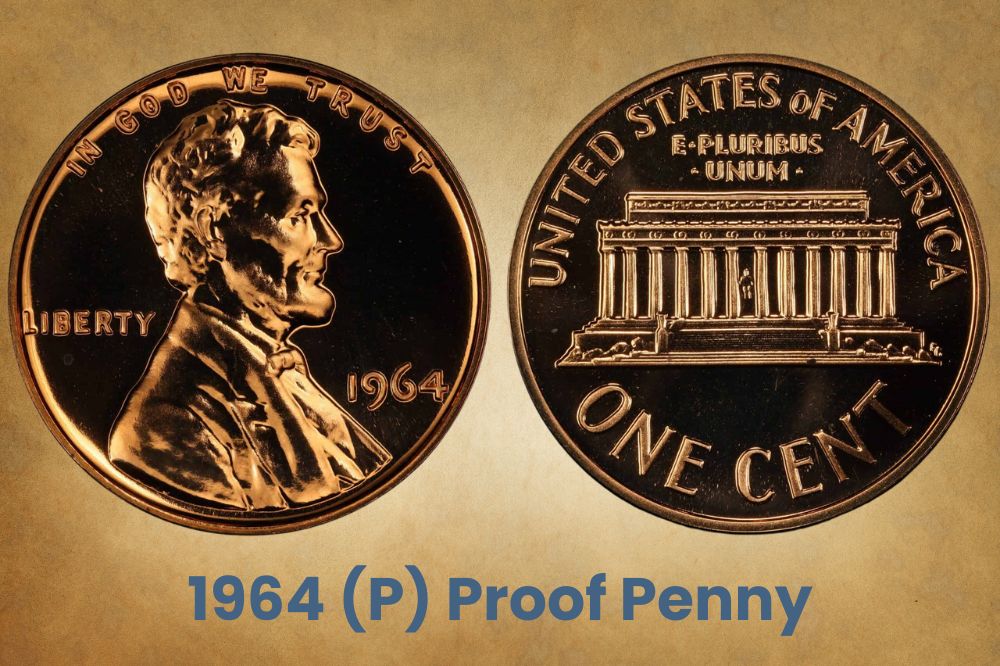
You may have noticed a coin graded as PR or PF. The PR means Proof and refers to coins minted in a particular way for collectors. This means the planchets are burnished before striking and the dies are specially processed to add clarity, definition, fine detail, and shine.
PF means Proof-Like. The coin may look sparkly and expensive but wasn’t made with pre-burnished planchets. In 1964, all proofs (close to 4M) were made in Philadelphia without mint marks. In PR 67 D-CAM, it’s $200. One unsold 1964 (P) PR 70 D-CAM was $12,500.
1964 Special Strike (SMS) Penny Value
Special Strike and/or SMS coins are often mistaken for proof coins. But SMS (Special Mint Sets) contain a coin from every denomination that’s circulating at the time. So a 1964 SMS would have a penny, a nickel, a dime, a half-dollar, and a dollar. But the 1964 Special Strike only had the 1964 Penny itself. In September 2019, a 1964 1c SMS MS 65 sold for $11,400.
Related Posts: 16 Most Valuable Wheat Penny Errors
1964 Penny Errors
When you find a damaged 1964 Penny, you can’t be sure if it got crushed on a railroad track or messed at the mint. Either way, certain coin errors can be quite valuable, launching your seemingly ordinary 1-cent coin into a treasure worth thousands of dollars! Let’s explore a few of the more common coin flaws, explaining how these mistakes are made and what they cost.
1964 Penny D/D RPM Error
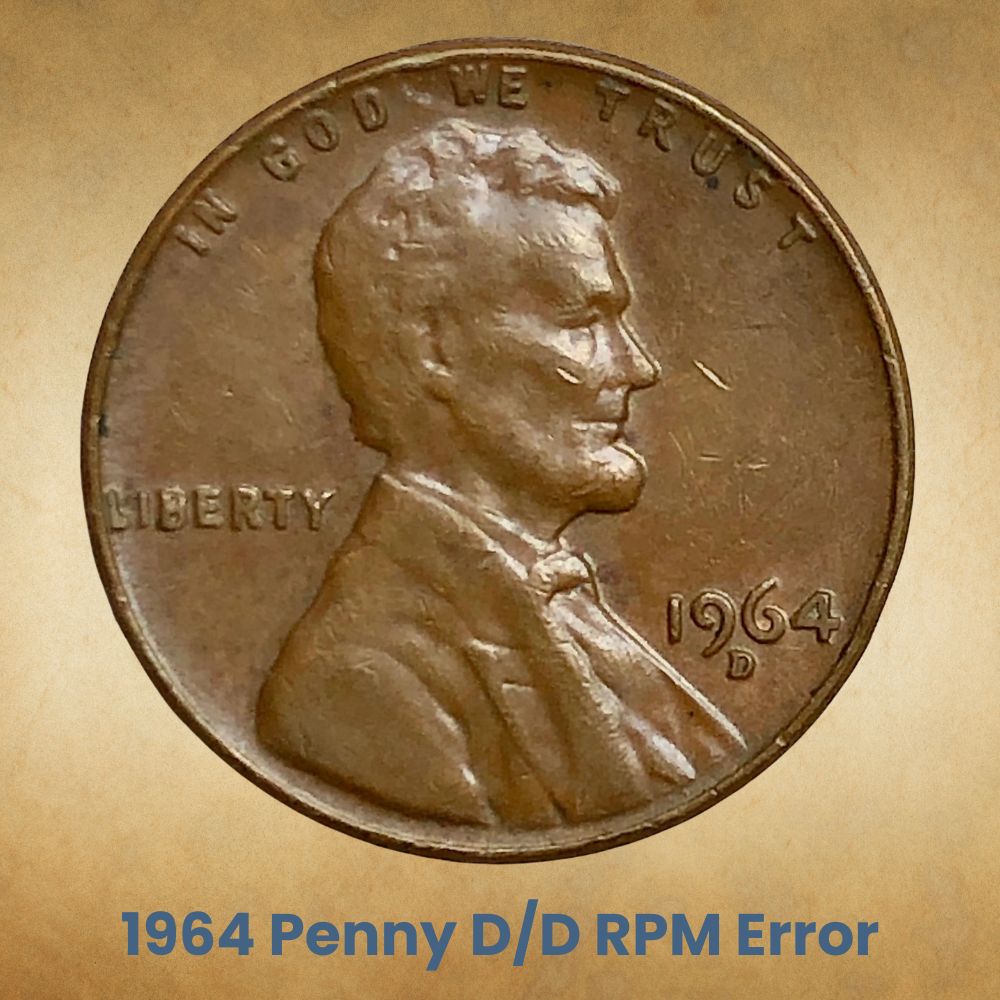
RPM means re-punched mint mark. Until 1989, mint marks were manually placed using a hand-held punch. And since every mint mark has to be stamped two or more times, any movement will shift the mint mark. In 1964, only Denver pennies had mint marks, so a coin with a re-punched D could be worth a few dollars. One sample in MS 65 RD only earned $10.
1964 Penny Struck Over a 1951 Penny
Coins are typically struck on blank discs called planchets. But sometimes, the die might strike a coin that already passed through the mint. In this case, a 1964 D Penny was struck on top of a 1951 D Penny, which was a Wheat Penny. The coin has a faded 1951 D in the upper left obverse and a faded Liberty on the right. In AU 58, the coin sold for over $1,800.
1964 Penny Struck Over a 1963 Penny
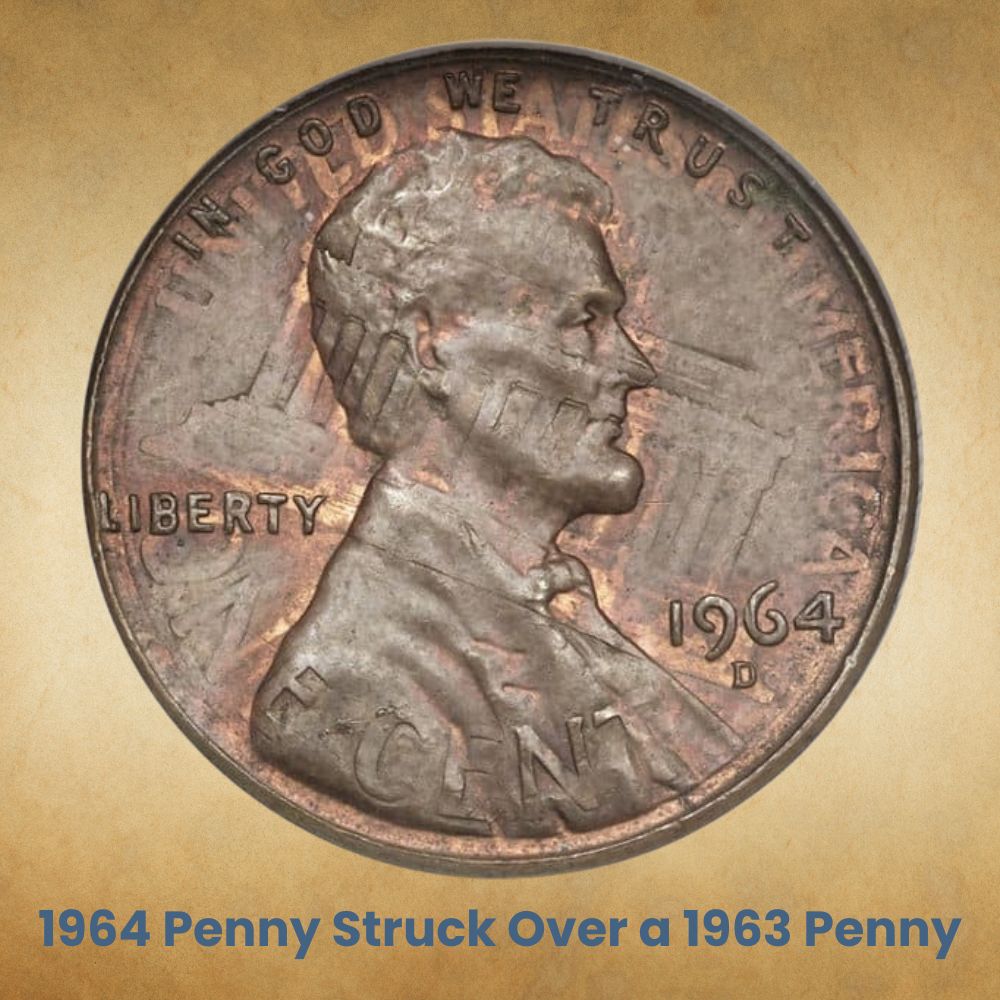
We’ve talked about the mix-ups in these years, so you may recall that most 1964 pennies were minted in 1965, and the bulk of 1965 pennies were coined in 1966. But here’s a 1964 D Struck on a 1963 D. You can see the reverse memorial silhouette under the obverse Lincoln and vice versa. You can also see 1963 on the back. In MS 64 BN (Brown), it sold for $4,000.
1964 Penny Cloth Strike Thru Obverse Error
A strike-thru (sometimes graded as strike-through or struck-thru) is when a foreign object gets between the die and the planchet during minting. In this case, a piece of fabric blurred Lincoln’s features and left a mesh-like weave on the coin. In MS 63 RB (reddish-brown), the coin sold on eBay for about $250. It’s not much, but it’s a lot more than the 1-cent face value.
1964 Penny Clipped Planchet Error
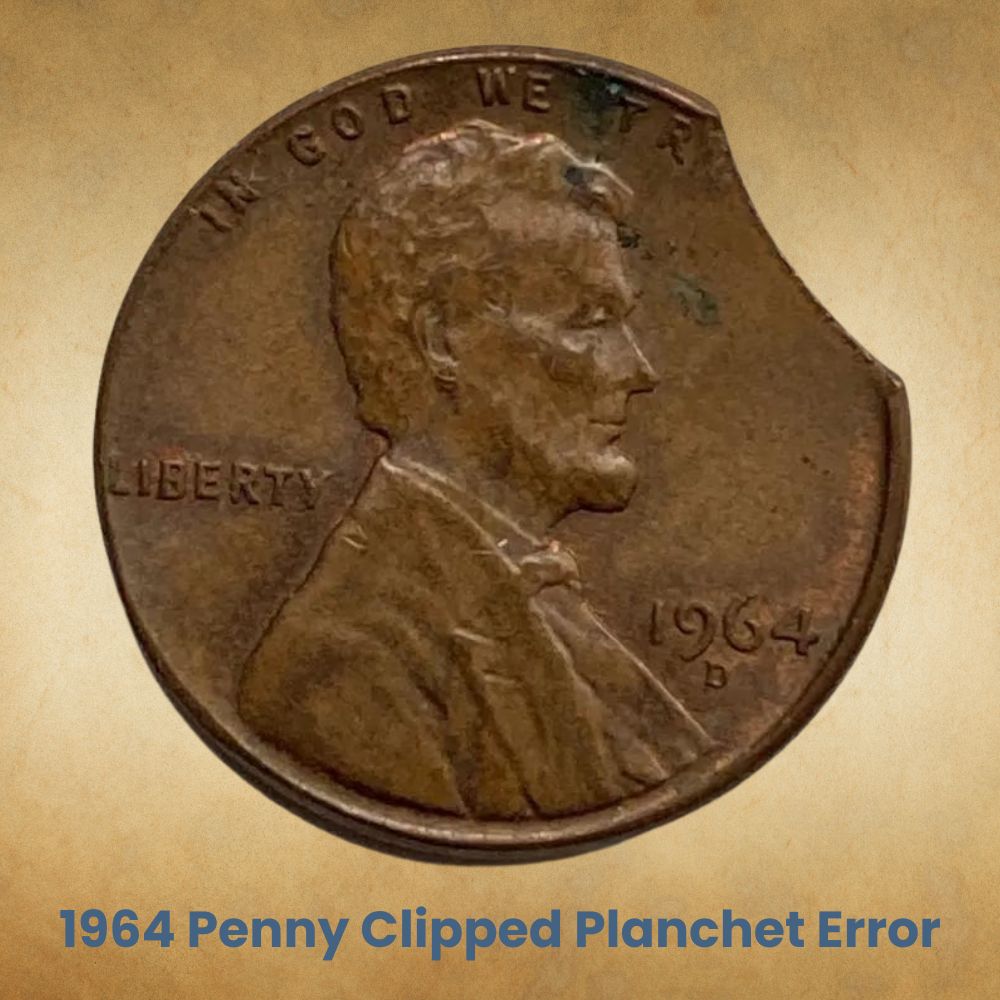
You might find a coin with part of its surface sliced off. This error could happen if the coin fell into some machinery and got chopped. But it could also happen at the planchet stage if the disc got sliced before or during minting. Clipped coin errors range in price. Some go for as little as $5, like this one with a clip that cuts through the coin’s lower front and upper back.
1964 Off-Centre Penny Error
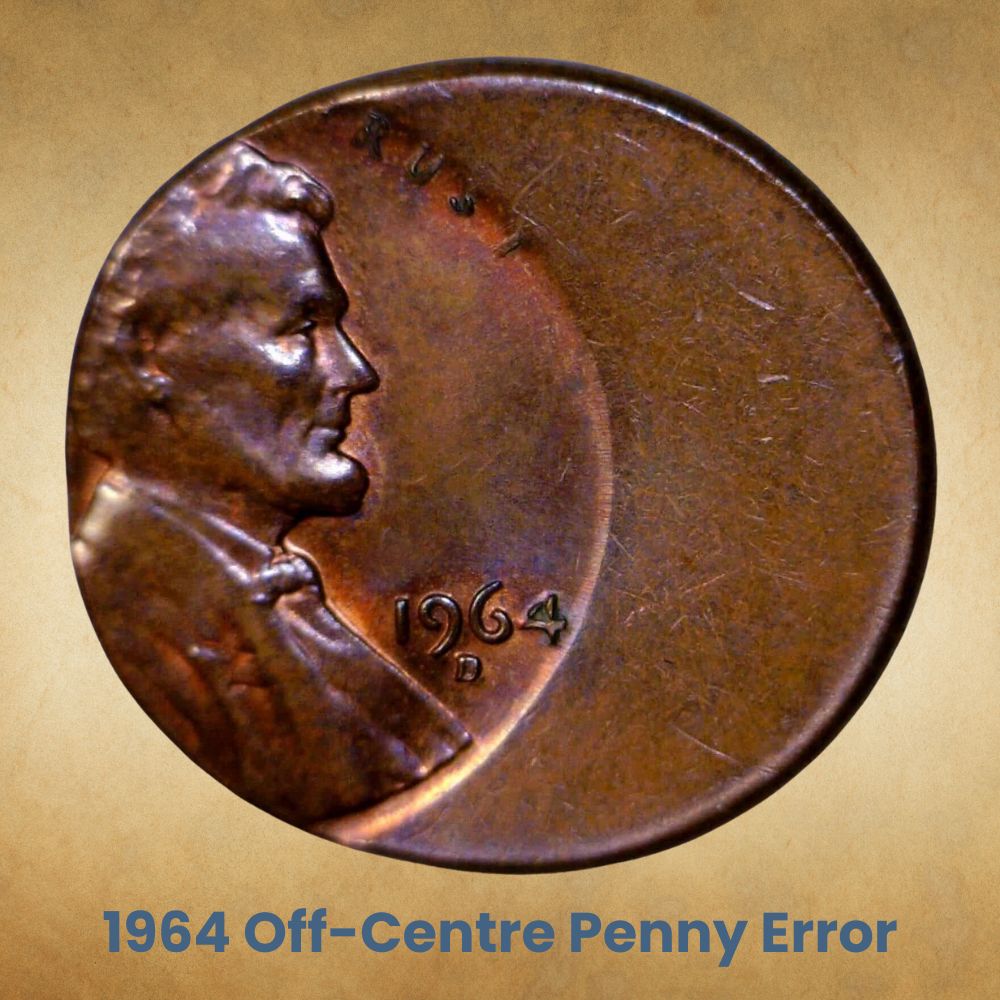
Some errors are so dramatic that they seem priceless! But that’s not always the case. One off-center penny only shows Lincoln’s forehead, nose, chin, chest, plus of course the 1964 mint date and the D mint mark. The rest of the coin is raw planchet, so it’s blank. At the back, you see America, the T in Cent, and part of the memorial. But this drastic flaw is only worth $30.
1964 Penny Struck on a Clad Dime Planchet
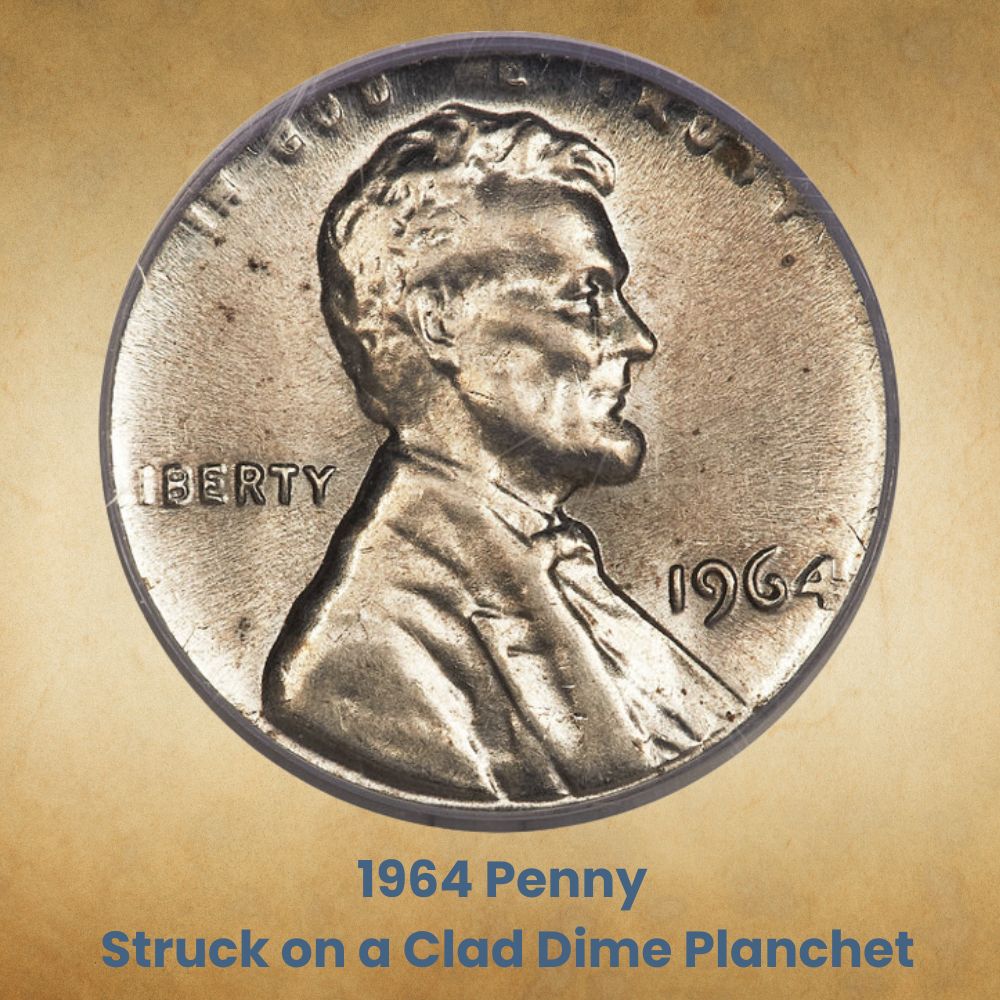
If a penny is struck on the wrong planchet (either the denomination or the metal mix), it may seem truncated and have some words or features chopped off. It will also weigh less. A 1964 penny struck on a clad dime planchet weighs 2.3g (instead of the usual 3.11g). The planchet was intended for an Eisenhower Dime, and in MS 65, this 1c coin sold for more than $4,800.
1964 MS 65 Deep Die Cap and Triple Strike Penny Errors
We’re classing these next two errors together because they both sold for about $1,100. And while they’re both easy to spot, the flaws vary. One MS 65 coin is triple struck so you can see three Lincolns on the obverse, with two of them being 60% and 70% off-center. The second MS 66 coin is a Deep Die Cap so the obverse seems weirdly sunken and the reverse is raised.
1964 Penny Minor Errors
A 1964 D with a staple strike-thru on the obverse is worth $70. Another coin with a far more vivid double-struck error sold for $90. One of its edges extends into an extra 64 on the obverse and a blurred United on the reverse. DDRs and capped die errors can fetch $20. As for the Lincoln-Kennedy novelty penny with a JFK caricature, that’s only worth face value.
Related Posts: 19 Most Valuable Lincoln Memorial Penny Worth Money
History of the 1964 Penny
A penny is a 1-cent coin in the United Kingdom, and here in the US, as a relic of colonial times, we call our 1-cents pennies as well. American pennies are known as Lincoln Cents because they’ve carried the portrait of Abraham Lincoln from 1909 to date. He was the first American President to be featured on any US currency, though others eventually followed.
Before him, portraits did have human subjects, but they were largely symbolic sculptures that represented liberty, peace, etc. This means you couldn’t identify the person that posed unless the sculptor or model admitted it. The Lincoln Cent has always featured Lincoln on the front, but the back design has changed over the years. 1964 Pennies is a Memorial Cents.
This means they feature the Lincoln Memorial on the back and Lincoln’s face on the front. Notably, most of the pennies stamped 1964 were actually coined in 1965. In total, the mint produced 6,447,646,500 that carried a minting date of 1964. But roughly 3B of those pennies were made in 1965. Out of the nearly 6.5B 1964 pennies, only 3.8B have mint marks.
They carry the D mint mark for Denver. As usual, coins from Philadelphia had no mint marks, but in 1964, the San Francisco coins lost their mint mark too. Over the next few years, this practice of omitting mint marks would be extended to other coins under Mary Adams. She was the Mint Director at the time, and she believed this would resolve the coin shortage.
As a curious spill-over, many coins marked 1965 were actually coined in 1966! Out of the 1,497,224,900 pennies dated 1965, about 1M were coined in 1965 in Philadelphia. All the rest were struck in 1966 across all three mints. So if you were looking, those 1M verified 1965 (P) cents could be priceless. But since no coins had mint marks that year, you can’t spot them!
Coin Shortages, Controversies, and Mint Marks
During the 1960s, specie prices were rising, so citizens were silver stacking. This is when you keep circulating silver coins as bullion. The plan is to melt them down and sell the raw silver for profit. This habit involves gold coins too, and sometimes extends to coins without silver or gold, so some base metal coins get hoarded as well, and these include 95% copper pennies.
During the Revolutionary War and the Civil War, people mostly hoarded gold coins. But the gold rush dropped prices and the market developed an appetite for silver. Looking at 1964, silver prices were especially high and silver stacking was a problem. Sometimes, the US Mint steps in to prevent coin stacking. They might try using a less valuable metal to mint the coin.
This is common during wars when nickel and copper were replaced with zinc, steel, or tin. In the 60s, several silver coins were switched over to the Johnson Sandwich, a mixture of copper and nickel to replace the silver. But starting 1964, Mary Adams suggested that coins shouldn’t have mint marks. She believed the hoarders were collectors rather than smelters.
This is because numismatists will sometimes seek coins with specific dates and mint marks, so Mary believed coins without mint marks wouldn’t interest them. So in 1964, only Denver pennies had mint marks, and from 1965 to 1967, no coins had mint marks. They reappeared on currency in 1968. Ironically, this made 1964 an even more attractive year for collectors.
Interestingly, between 1965 and 1967, the Mint didn’t make Proof coins. Instead, they made SMS (Special Mint Sets). They resemble proof coins, but while proofs and other coins are struck multiple times, SMS coins are only struck once, with higher pressure to ensure clarity and make up for the missing strikes. Also, all SMS pennies dated 1965 were coined in 1966.
Related Posts: 19 Most Valuable Wheat Penny Worth Money
how to identify 1964 Penny
The 1964 Penny still carries its original obverse (heads side) but its reverse (tails side) is the third design in this famous – and sometimes controversial – coin series. Let’s flip this coin and check out its features. It can’t buy much today, but its collectors’ value is still quite high.
The Obverse of the 1964 Penny
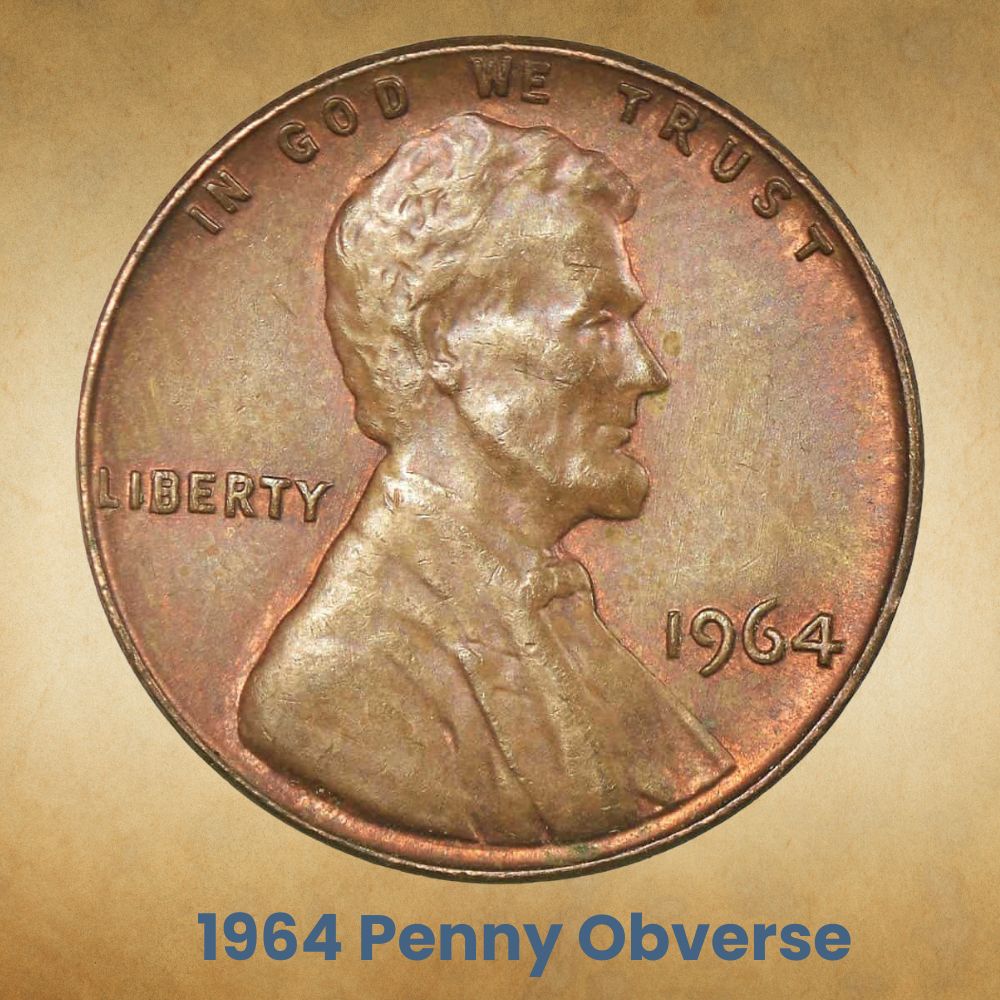
The obverse (heads side) of the 1964 penny features Abraham Lincoln as the device. (The device is the image or the portrait, while the field is the background of the coin.) He faces to the right, and the sculpture is based on a 1907 desk plaque that Victor Brenner designed for Gorham Manufacturing. The obverse has the legend In God We Trust on the upper collar.
On the left, behind Lincoln, is the legend Liberty, and on the right, next to his chest, you’ll find the date (1964) and the mint mark. But remember, most of these coins were made in 1965, and only the Denver ones have mint marks. At the portrait’s shoulder cut-off, VDB identifies Victor David Brenner as the obverse designer. He made the original reverse too.
The Reverse of the 1964 Penny
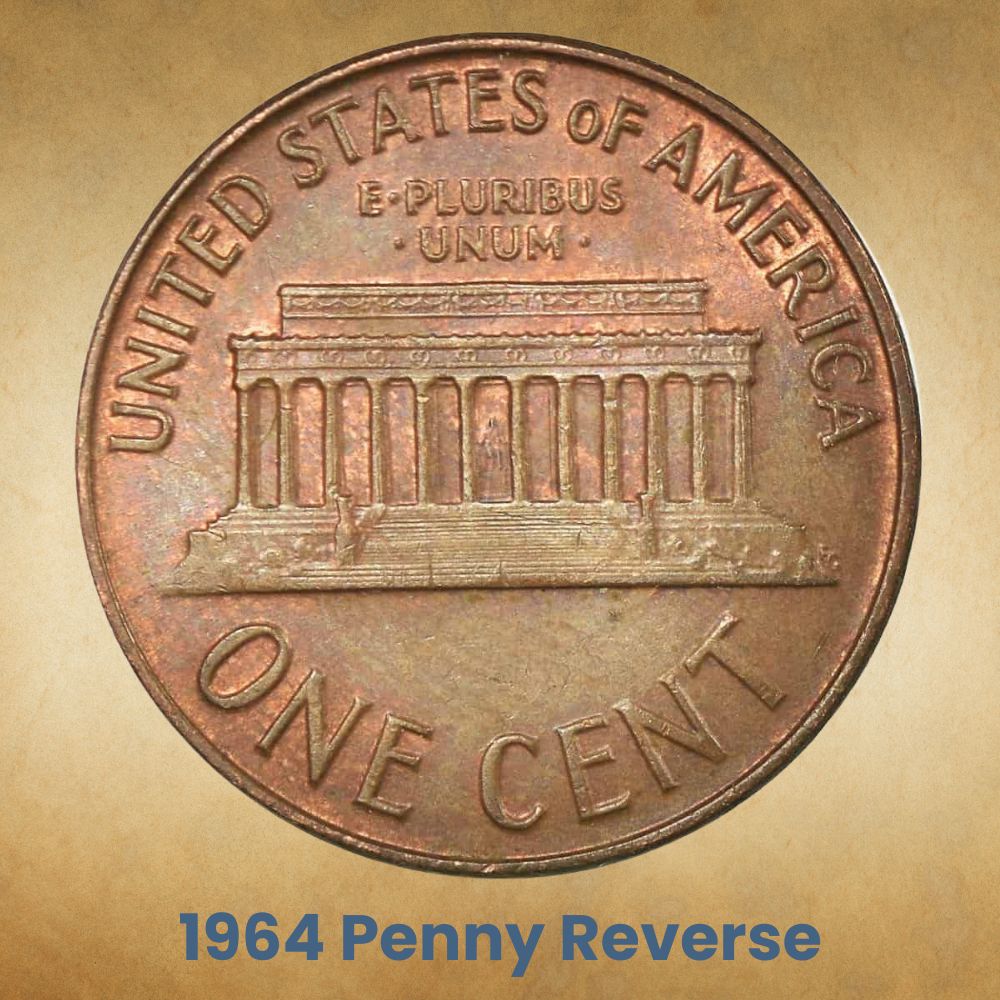
The reverse (tails side) of the 1964 Penny features the Lincoln Memorial. This reverse was designed by Frank Gasparro. He was the Assistant Mint Engraver at the time, but he got promoted to Chief Engraver in 1965. His initials, FG, sit on the right of the memorial steps. On highly defined coins, you can see Lincoln’s statue peeking through the central pillars.
The upper collar reads United States of America, with E Pluribus Unum directly beneath. There’s a dot after the E and on both sides of the Unum. The lower collar of the coin reads One Cent in a massive font. This Memorial Penny was coined from 1959 to 2008 when it was replaced by four alternative reverse designs on the Bicentennial Penny. Both are 95% copper.
Other Features of the 1964 Penny
The two most notable features of the 1964 Penny are that one, half of them were coined in 1965, and two, only the Denver coins bore mint marks. As usual, the Philadelphia (P) coins had no mint marks, but in 1964, the San Francisco (S) coins had no mint marks either. The 1964 penny is 19.05mm in diameter (0.075”) with a smooth or plain edge. It weighs 3.11g.
FAQs About the 1964 Penny
How Much is a 1964 Old Penny Worth?
In low grades, circulated 1964 pennies are only worth 2 cents or so, based on their copper content. But PCGS has graded a few coins quite highly even though they never sold. A 1964 PR 70 D-CAM was evaluated at $12,500 while a 1964 MS 65 Special Strike sold for $11,400.
Why is a 1964 Penny Rare?
While close to 6.5B pennies bear the 1964 Mint Date, roughly half were coined in 1965. So in theory, 1964 pennies are rare. But since so few of these coins show their true mintage year, you can’t tell which ones are from 1964 and which ones are from 1965. Also, few of these coins have survived in high grades, so if you check coin grading sites, their listings seem rare.
How Can You Tell if a Penny is 1964 SMS?
First off, there were no SMS pennies in 1964, so when you say 1964 SMS, you probably mean 1964 Special Strike. It’s still referred to as SMS because it was coined in the same style as SMS coins. You can tell it’s a Special Strike if it has square edges, a satin-like surface, a non-reflective finish, and sharp features. Ungraded SMS are sometimes described as proof-like.

hello how about the
ose 64s that look like they were type on just you would type on paper thats what have in my collection i three 3 out 4 not bad being at the right place at the right time
I have a 1964 d and the mint mark is touching the date. What’s it worth?
I have one where the back print is all backwards
I have a 1964 penny where on the back all the writing is backwards
I have the 1964 penny in very very good condition. Can show if requested.
I have a 1964 penny and it has two faces one faces like a little line that goes around the other face and it has a large six on a 1964 it’s in very very good shape